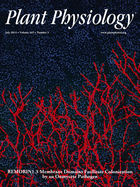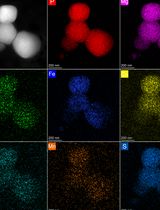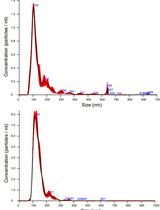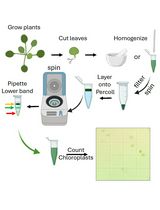- EN - English
- CN - 中文
Isolation of Chloroplast Inner and Outer Envelope Membranes
叶绿体内膜和外膜的分离
发布: 2015年02月20日第5卷第4期 DOI: 10.21769/BioProtoc.1405 浏览次数: 15233
评审: Tie LiuAnonymous reviewer(s)
Abstract
The chloroplast is an important organelle found in plant cells that conduct photosynthesis. It is enclosed by a pair of closely spaced membranes, the double-membrane envelope, consisting of the inner membrane bounding the matrix or stroma and the outer membrane in contact with the cytoplasm. Like many bio-membranes, the chloroplast envelope plays an important role in mediating the complex interactions between the chloroplast and the cytoplasm. The envelope is also the site of various biosynthetic reactions, including the formation of the galactolipids, which are the major components of both envelope and the thylakoid membranes. The inner and outer envelope membranes have differences in both structure and function. For example, the outer membrane exhibits lower density of intramembranous particles than the inner membrane dose, suggesting that the protein content of the outer membrane is low. Also, the outer membrane is nonspecifically permeable to low molecular weight compounds, whereas the inner is impermeable to such compounds and contains several translocator systems for the transport of metabolites.
To prepare the envelope membranes, it is necessary to isolate intact chloroplasts first. Then the inner and outer envelope membranes are separated by: 1) the protease-treatment method and 2) the centrifuge method which based on the fact that the outer envelope is lighter and the inner membrane heavier. Both methods need to isolate the intact chloroplasts firstly. However, the centrifugal separation can get the pure inner and outer envelope preparations, which therefore are suitable to the subsequent analyses. Also, the centrifuge method can avoid the destruction of inner envelope polypeptides during the protease treatment, because some of the protease may gain access to the inner membrane. Moreover, the centrifuge method is easy to operate and to get the complete enveloped that contain less of the adhesion regions of the outer and inner envelope membranes. Here we describe a reliable method for isolation of the inner and outer envelope membranes of the chloroplasts from tobacco, which is the plant that relatively not easy to use for envelope isolation.
Materials and Reagents
- 6-week old tobacco (Nicotiana tabacum) plants (3-week after sowing, the seedlings were transplanted and grew for another 3 weeks)
- 2-(N-morpholino) ethanesulfonic acid monohydrate (MES) (Dojindo Molecular Technologies, catalog number: 345-01625 )
- 2-[4-(2-hydroxyethyl)-1-piperazinyl] ethanesulfonic acid (HEPES) (Dojindo Molecular Technologies, catalog number: 342-01375 )
- Sobitol (Wako Pure Chemical Industries, catalog number: 191-14735 )
- di-sodium dihydrogen ethylenediaminetetraacetate dihydrate (EDTA-2Na) (Nacalai tesque, catalog number: 15111-45 )
- Manganese chloride tetrahydrate (MnCl2.4H2O) (Nacalai tesque, catalog number: 13446-34-9 )
- Magnesium chloride hexahydrate (MgCl2.6H2O) (Nacalai tesque, catalog number: 7791-18-6 )
- Sodium hydroxide (Nacalai tesque, catalog number: 1310-73-2 )
- Sodium chloride (Nacalai tesque, catalog number: 7647-14-5 )
- Isoascorbic acid (Nacalai tesque, catalog number: 89-65-6 )
- Polyvinylpyrrolidone (Sigma-Aldrich, catalog number: PVP40 )
- Percoll (GE Healthecare, catalog number: 17-0891-01 )
- Pyrophosphate aci (Wako Pure Chemical Industries, catalog number: 163-05485 )
- Glutathione (Wako Pure Chemical Industries, catalog number: 071-02014 )
- Tricine (Nacalai Tesque, catalog number: 5704-04-1 )
- Sucrose (Nacalai tesque, catalog number: 57-50-1 )
- Acetone (Wako Pure Chemical Industries, catalog number: 016-00346 )
- Extraction buffer for homogenization (see Recipes)
- Gradient buffer (see Recipes)
- TE buffer (see Recipes)
- 40% (v/v) Percoll in gradient buffer (see Recipes)
- 90% (v/v) Percoll in gradient buffer (see Recipes)
- 0.2 M, 0.6 M and 1.2 M sucrose in TE buffer (see Recipes)
- Linear gradient of 0.6~1.2 M sucrose-TE buffer (see Recipes)
Equipment
- Juicer mixer (TESCOM, model: TM837 )
- Scissors
- pH meter (Horiba, model: F-71S )
- Refrigerator 4 °C and -20 °C
- Funnel
- Centrifuge tube (250 ml, 50 ml, and 10 ml for ultracentrifuge)
- Miracloth (Calbiochem, catalog number: 475855 ) and/or gauze
- Paint brush with soft hair
- Pasteur pipet
- Spectrophotometer (Shimadzu, model: MPS2000 )
- Density gradient device (round type, inner diameter: 10 mm, total volume: 10~15 ml) (Sanplateccorp)
- Magnetic stirrer (Pasolina, model: TR-300 )
- Super centrifuge (Hitachi, model: CR20F )
- Ultracentrifuge (Hitachi, model: CP 70MX )
- Syringe (1 ml volumn)
Procedure
文章信息
版权信息
© 2015 The Authors; exclusive licensee Bio-protocol LLC.
如何引用
Readers should cite both the Bio-protocol article and the original research article where this protocol was used:
- Wang, S., Yin, L., Mano, J. and Tanaka, K. (2015). Isolation of Chloroplast Inner and Outer Envelope Membranes. Bio-protocol 5(4): e1405. DOI: 10.21769/BioProtoc.1405.
- Wang, S., Uddin, M. I., Tanaka, K., Yin, L., Shi, Z., Qi, Y., Mano, J., Matsui, K., Shimomura, N., Sakaki, T., Deng, X. and Zhang, S. (2014). Maintenance of chloroplast structure and function by overexpression of the rice MONOGALACTOSYLDIACYLGLYCEROL SYNTHASE gene leads to enhanced salt tolerance in tobacco. Plant Physiol 165(3): 1144-1155.
分类
植物科学 > 植物生理学 > 光合作用
植物科学 > 植物细胞生物学 > 细胞器分离
细胞生物学 > 细胞器分离 > 叶绿体
您对这篇实验方法有问题吗?
在此处发布您的问题,我们将邀请本文作者来回答。同时,我们会将您的问题发布到Bio-protocol Exchange,以便寻求社区成员的帮助。
提问指南
+ 问题描述
写下详细的问题描述,包括所有有助于他人回答您问题的信息(例如实验过程、条件和相关图像等)。
Share
Bluesky
X
Copy link












